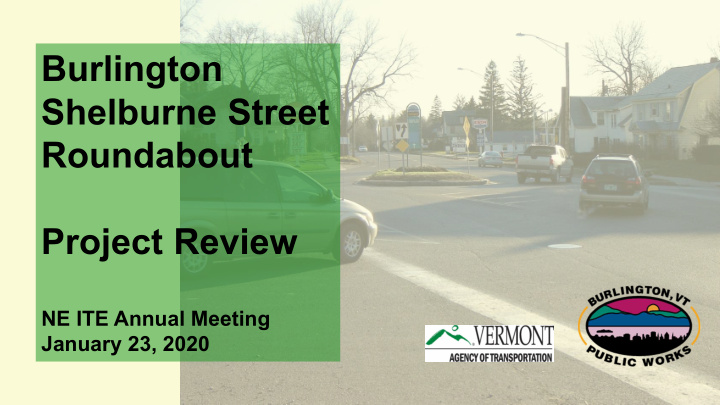



Burlington Shelburne Street Roundabout Project Review NE ITE Annual Meeting January 23, 2020
The “Rotary”
The “Rotary”
The “Rotary” Not much has changed with the streets in nearly 80 years. The “rotary” proper was enlarged and raised but much that has changed has been with business/residences and landscaping. The “Rotary” in 2011.
Identified Issues Vehicle Volumes = 19,200 vpd High Crash Location • In 2006 = 53 reported crashes in 5 years • In 2016 = 50 reported crashes in 5 years • Has been on the HCL since at least 1998 – consecutively The “Rotary” • Improper size and shape • Too small and restricts certain movements and storage • Improper location within the intersection for sight distance and sight lines Left Turns • Generally high throughout the intersection • Awkward left turns around the “Rotary” Uncontrolled drive accesses • At Century 21 & Majestic Car Rental Adjacent School and Churches • Destination for pedestrians Elevated presence of bicyclists and pedestrians • Especially children to/from school • Long existing crosswalks • Inadequate number of crosswalks Aesthetically unappealing • A sea of pavement • Lack of landscaping Aging and failing (or soon-to-be failing) utilities • 37,000 linear feet (> 7 miles) buried utilities Lack of modern stormwater treatment
The Solution The Modern Roundabout Waterbury, VT: US Route 2 & VT Route 100
The Solution
The Solution The Modern Roundabout • Can handle the 19,200 vpd without needing new lanes (i.e. dual lane roundabout). • Expected crash reduction of up to 72% (per FHWA CMF Clearinghouse). • Geometry of the roundabout focuses user’s sight lines by obscuring and revealing certain perspectives. • Left turns become right turns (in most cases) and become more predictable to all users. • Adjacent drives will be controlled. • Crosswalks will be shorter in length (only must cross one lane at a time at the splitter islands, which will be in highly visible locations. • The Central Island will create opportunity for aesthetic treatments (creation of a city gateway). • Buried utility infrastructure will be relocated and consolidated in duct banks for easy and safe maintenance accessibility. • New buried sand filters and detention vaults will treat previously untreated stormwater runoff without surcharging existing accepting systems.
Challenges to Implementation No Small Feats LEDGE & GLACIAL TILL • Borings located at depths of 3’-17’. Several knobs visible at surface throughout. • Blasting in close proximity of houses and businesses will be a challenge. The bedrock is not conducive to drilling and ripping.
Challenges to Implementation No Small Feats ARCHAEOLOGY • Phase I and II Archaeology investigations yielded Native American artifacts in the form of stone chips from tool manufacturing. • A Phase III Arch activity will collect some of the artifacts during construction.
Challenges to Implementation No Small Feats STORMWATER TREATMENT • Existing dedicated storm system down Locust. • Existing combined storm/sewer system down Shelburne to Englesby Brook (impaired). • Maintain intact until new system is constructed. • New system to filter and detain storm events without exasperating the existing surcharged downstream systems.
Challenges to Implementation No Small Feats CONTAMINATED SOILS & GROUNDWATERS Environmental Site Assessment (ESA) currently under way. • 4 gas stations in the last 90 years • 2 SMAC’ed by DEC • 1 Currently under mediation • 1 Active • Vermont Limited Re-Use Soils (VLRS) anticipated • Top 6” existing pervious turf removed if not re-used on site.
Challenges to Implementation No Small Feats UTILITIES • Performed a Subsurface Utility Exploration (SUE) in 2015. • Performed Quality Level B investigation (GPR) • Performed Quality Level A investigation (Potholing) at
Challenges to Implementation No Small Feats UTILITIES • 37,000 linear feet of existing utilities • Some abandoned, most active • Gas • Sewer • Water • Electric • Telephone • Telecom • Fiber • Cable • Storm
Challenges to Implementation No Small Feats UTILITIES • Utility Duct Bank (Concrete- encased) • As small as 1x3 • As large as 5x4 • New Water Line • Sleeve existing sewer lines in 2020 (UV Cured). • Trick is to keep existing active services on while build new infrastructure.
Challenges to Implementation No Small Feats TRANSPORTATION MANAGEMENT • Maintain pedestrian and bicycle accommodations through construction • Detours for certain construction phases • Restrict Left Turns during construction (certain phases) • Potential off-site student pick- up/drop-off locations • Comprehensive Construction Phasing/Sequencing Plan
Schedule & Budget Budget Schedule 100% Federal Funded (Safety funds) ROW Clear: March 2020 $500,000 for duct bank PS&E Completion: January 2021 $1,000,000 for reimbursable relocations Bid Advertisement: February 2021 ____________________________________ Construction: May 2021 – June 2023 $7,000,000 total
Follow VTrans on Social Media Facebook: @VtransOnTheRoad Twitter: @AOTVermont Instagram: @AOTVermont YouTube: VTransTV Flickr: VTrans
Recommend
More recommend